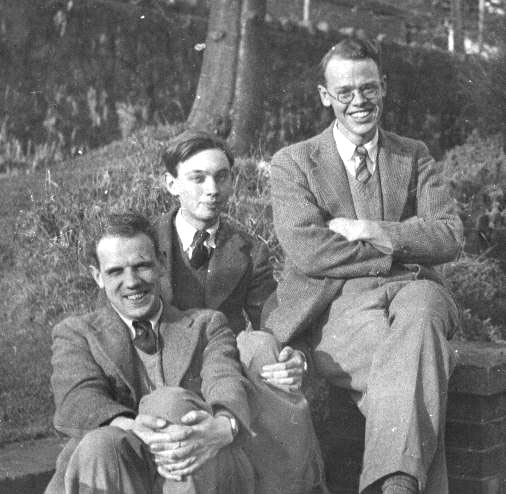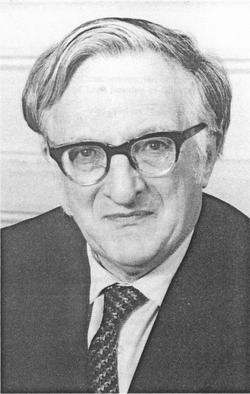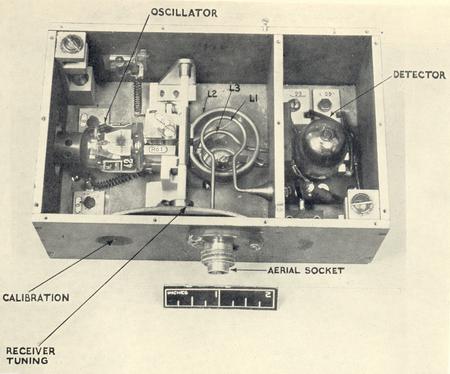Memoirs of a Boffin
Chapter 4: Boffins at War (1942-1944)
Some months before the move to Malvern, I had bought a bright red Marendaz Special 13/70 open sports car from a colleague, Nat Marshall for 16 guineas. It resembled a Bentley, but was somewhat smaller. This 1½ litre beauty had triple chrome exhaust pipes curving out of the side of the engine, a Moss gearbox, Bishop steering and knock-off racing wheels. It was my pride and joy.
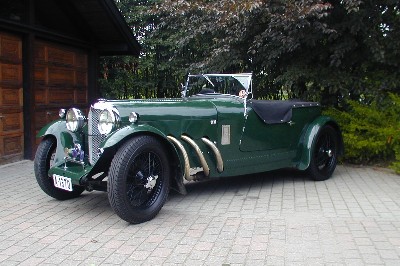
A handsome green Marendaz Special 13/70
The photos of a Marendaz Special 13/70 are reproduced here courtesy of Per A. Aasvestad. It is one of fewer than a dozen in the world still running after almost 70 years.
Even in 1942, the Marendaz Special 13/70 was a rarity. Captain Marendaz left Bentley in 1926 to form a Company of his own – D.M.K. Marendaz Ltd. which assembled the first Marendaz Specials, a souped-up version of which had some success in racing at Montlhéry in France. In 1932 he formed Marendaz Special Cars Ltd. in Maidenhead, Berks. where the first production cars were made. Later models included a 2½ litre 17/97 and a 2 litre 15/90 which was reviewed in “The Autocar” for 29 November 1935. Production of Marendaz Specials ended in 1936. It is believed thet fewer than 100 13/70s were made and the owner claims that the one shown here, which was made in August 1932, may have been the very first.
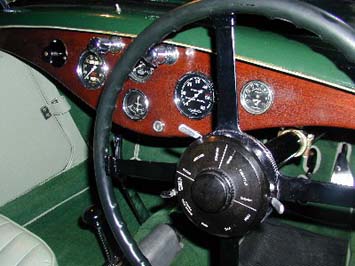
The Dashboard of the Marendaz Special
But, at the time we had to move TRE north to Malvern, the car was in pieces, some on the floor and some hanging on the walls of a small rented garage at the top of the hill in Langton Matravers. I only had a day or two to fit in the job of reassembly; no time for tests. Early on the morning of the 25th of May 1942, I set out with three of my colleagues. The four of us pushed the Marendaz Special out of the garage, poised it on the top of the hill, climbed in and I took off the hand brake. It started down the hill. With a little prayer I let in the clutch. Thankfully, after a few coughs and splutters it started. So we headed up to Great Malvern. About half-way there I lost my way in a maze of country lanes. The turns were so sharp and the turning-circle of the Marendaz Special so wide that I had to drift it round many of them in order to keep up a decent speed.
Then the engine began to die. It would run on idle, but as soon as I touched the accelerator it would pass out: diagnosis fuel starvation. So I dismantled and cleaned the carburetor, disconnected the fuel feed and blew down the pipe towards the tank. Nothing! I blew until my face was red; but it was blocked. F.D. ‘Bill’ Boardman, a close friend and one of the passengers (Andrew McLatchie was one of the others) said “Give it to me.” He blew out his cheeks and gave one almighty puff down the pipe. There was an encouraging gurgle from the tank. I reassembled the fuel system and we were on our way.
Our first call in Great Malvern was at a pub on the Worcester Road. We were parched and the lingering taste of the leaded gasoline was not too pleasant. Bill, who rarely drank alcohol, ordered a pint of cider, then another. His normally florid complexion became bright red. Then the landlord explained that the cider was a particularly potent brew and strong men had been known to wilt after only one of them. It was a relaxed crew that finally arrived at House 5 of Malvern College, which had been allocated as a men’s residence for TRE staff. The picture shows Bill Boardman, Andrew McLatchie and myself taken outside House 5 not long after we were settled in Malvern:
The Malverns consist of several towns or villages dotted around the northern end of the Malvern Hills. There is Great Malvern (not surprisingly the biggest), Little Malvern, Malvern Link, Malvern Wells, West Malvern, and North Malvern. Great Malvern is on the Eastern slopes of the Worcestershire Beacon, which is the highest of the Malvern hills so, in the town, the sun sets behind the Beacon an hour or two earlier than it sets on the plain. The College, like the Priory Church is in Great Malvern. It was in Malvern that I met my nemesis in the shape of a 90 lb 18-year-old girl exactly one year from the day of our arrival. But more of that later.
We set up the IFF Labs in House 2 of the College. The College Houses were grouped around the playing fields. House 2 accommodated all transponder work: IFF under Bowden on the ground floor and radar beacons under J.W.S. Pringle and Hanbury Brown on the second. House 8 was given over to radar countermeasures, under Bob Cockburn and Martin Ryle. (Both Cockburn and Ryle were knighted after the war and Ryle was awarded the Nobel prize for physics in 1966). House 3 housed Donald. Fry’s Division. The centimetre radar group now had the Birmingham magnetron and was in the capable hands of P.I. Dee with Bernard Lovell, Bill Burcham, and Griff Roberts. A new building, the Preston Lab. was erected in the College grounds to house this expanding work. The circuit division, under F.C. Williams, occupied the cricket pavilion.
One year after our arrival in Malvern we had an Anniversary Ball in the Assembly Hall of Malvern College. It was there that I met my wife-to-be, Nesta, who lived in West Malvern. The requirements of “national service” had taken her from Mr Baylis’s friendly pharmacy in Great Malvern, at the age of eighteen, to work in this high-priority government research establishment with Professor Dee from Glasgow, Bernard Lovell (later of radio-astronomy fame) Alan Hodgkin (later, President of the Royal Society) and Bill Burcham. In spite of a few years difference in age, we were kindred spirits and soon became close friends. The next few months kept me very fit. There were only two ways to reach West Malvern: either cycle round the North Hill and chug up the road on the other side or walk right over the Worcestershire Beacon. I did both – often.
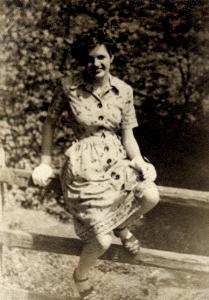
Nesta: Summer 1942
Soon after we moved to Malvern negotiations had started with the USA on the development of an IFF system that would be a successor to Mark III. Vivian Bowden had flown over to Washington to discuss it. When he returned I asked, sort of casually, “How was the trip?” He replied “They flew us there in a Liberator (a US-made bomber). We were dressed in Sidcot flying Suits, given oxygen masks and stacked in the bomb bays like so many sausages. I spent the first half of the trip worrying whether they might open the bomb bays by mistake and the second half wishing they would!”
That was vintage Bowden. He was one of a kind – erudite, brilliantly creative, sometimes infuriating, but never dull. He was well-versed in the classics as well as the sciences. He was outgoing, often outrageous and very kind to us. He was the master of the quick humorous response, whether original or quotation. For instance, the Chief Superintendent of TRE, A.P Rowe sent for him on one occasion on an urgent matter. The story goes that Bowden, who was always a little portly, puffed up the stairs to Rowe’s office and arrived quite breathless. Rowe (who was a stickler for discipline and fitness) said “Bowden, you’re out of condition; what do you do when you feel like taking exercise?” Bowden is said to have replied “I lie down ‘til the feeling wears off.” Rowe was not amused. In later years, when Bowden was given a Life Peerage as Lord Bowden of Chesterfield I reminded him of this story and suggested it was the basis for his choice of title. (In fact, the city of Chesterfield in Yorkshire was his birthplace).
With Bowden away in the USA, I now reported directly to Dr. W.B. Lewis who was the Deputy Chief Superintendent of TRE. Lewis, like Bowden had been in the Cavendish Laboratory of Cambridge University before the war, up to the time they were pressed into working on radar by the Tizard Committee, as I had been. They were good friends. Between them, they had a profound influence on our future. They had very different personalities. Lewis had a great intellect and an encyclopaedic mind for the physical sciences, but had few outside interests. He became head of TRE after the war, for a year or two, then emigrated to Canada to create the Research Laboratories of Atomic Energy of Canada Ltd. in Chalk River, Ontario, where he devised the CANDU nuclear power reactor – one of the most reliable and successful operational reactors in the world.
Lewis lived mainly for his work, right up to the time of the prolonged illness resulting in his death in Deep River, Ontario in 1987. Of all the great scientists in Canadian history, Lewis was possibly the most brilliant and certainly the least appreciated by successive governments. He never received the recognition he deserved. Some of his achievements were recorded in a biography which was written a few years after his death:
“Nuclear Pursuits: The Scientific Biography of Wilfrid Bennet Lewis”, by Ruth Fawcett; McGill-Queen’s University Press, 1994).

Dr. Wilfrid Bennet Lewis
Lewis was to play a key role in our future but, back in 1943, he needed someone to help the intelligence service by examining and analyzing captured German airborne equipment and reporting on it, with a view to using the information operationally. I scanned the intelligence reports for items of interest. The first thing I noticed was a reference to something called FuGe 25a, which looked as though it might be an IFF Transponder. So I asked if intelligence could get a circuit diagram. After saying, out of habit, “you don’t want much do you?” they got one within a couple of weeks, adding the information that there were only six prototype models of the equipment in existence. I asked them if they could obtain one of the prototypes. After the usual grumbling, they came up with one – brand new and perfect. So I ran it up, made the tests and was writing the report when I was asked by the intelligence service whether I would like another one. It transpired that the Germans had been doing flight tests on the prototype in cooperation with radars on the French coast. At the end of the tests the young pilot was apparently near the English coast and, in a fit of bravado, did some aerobatics, with limited success, because he hit the ground in the south of England. The aircraft was demolished, but the FuGe 25a had been thrown out into a bush and survived. Now I had two and they had four! The detailed knowledge thus acquired of German IFF led directly to an operation that resulted in one of our great aerial victories of the war.
The German engineering was rugged compared to ours. They used cast metal chassis, with compartments cast in for each sub-circuit, while we used bent metal sheet. This turned out greatly to our advantage because the radar war changed from week to week. Our designs were easy to adapt and modify. Their designs were essentially immutable. The result was that we could keep up with the changing operational needs. They could not.
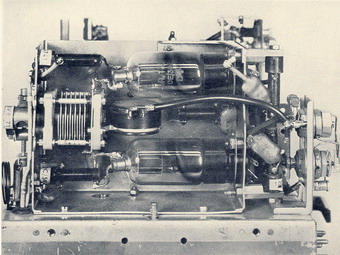
The radio-frequency section of our IFF Mark III transponder
The second piece of German equipment I examined was the Lichtenstein Airborne Interception (AI) radar. It was of particular interest to me because it used a superregenerative receiver. It seemed strange that the Germans used a conventional superheterodyne receiver for IFF, but a superregenerative receiver for AI – exactly the opposite of our practice. Of course, I believe we had the right approach, because our IFF circuit was much more economical and our AI more sensitive than theirs. The photo below of the captured equipment was taken at a time when the Lichtenstein Airborne Interception was in full use by the Luftwaffe:
We were always interested in where the German equipment was designed and made. For this, I called in Wing Commander Derek Jackson. Jackson was a remarkable character, being at once a noted Oxford research spectroscopist, a millionaire, owner of the notorious Sunday newspaper “The News of the World” and married to one of the Mitfords – a sister of Hitler’s girl friend. He was also a pioneer of night fighter airborne interception (AI) operations. Jackson knew the German scientific world intimately, took one careful look at a component and could often say where it was designed and made and who made it. This helped to pinpoint key factories and research labs as targets. Also working with me for a short time was the son of Chaim Weissman, the Prime Minister of Israel. He was in the RAF also. I heard later (but never confirmed) that he had been lost over occupied territory and executed as a spy under the pretext that his uniform was just a cover.
During 1943 we had occasion to use our knowledge of the FuGe 25a German IFF in a quite remarkably effective way. The Germans were sending over waves of about 60 bombers by night to attack specific targets in various cities. Only about six of the aircraft navigated to the target, dropping flares to mark it for the bombers. These, the FuGe 25a-equipped ‘pathfinders’ were controlled from northern France using the fact that a transponder response is many times stronger and therefore reliable at a much greater range than a radar echo. They measured the range of the transponder from two radar stations a known distance apart, then calculated its position by triangulation. The trouble the RAF had was to identify which were the pathfinders amongst all the attacking aircraft, as they came across the channel, in order to stop them before they got to the target.
I suggested that, as we were perfectly familiar with the FuGe 25a, we could isolate them on a special radar tuned to the frequency of the FuGe 25a transponder, that is to say on one or more of our mobile radars suitably modified. At the same time I suggested fitting a squadron of Mosquitoes with simulated FuGe 25a transponders, so that we could see both the pathfinders and the Mosquitoes on the same screen, free from the clutter of the 60 or so attacking aircraft, whose position didn’t matter until the pathfinders had done their work. Moreover, we would also benefit from the enhanced transponder range on our own fighters which could therefore be deployed as close as they dared to the French coast.
These suggestions were approved at a Sunday Soviet (q.v.) as Operation “Red Queen”. Of course one problem was to distinguish their aircraft from ours, because, according to this plan they would all appear to be carrying FuGe 25a transponders. Like our IFF Mark III, FuGe 25a had provision for coding its signals. We did not know whether they would all be sending the same code or individual ones. But I did know the range of all possible codes in the FuGe 25a. So I designed a code for our simulated FuGe 25a transponders that lay outside that range and was therefore immediately distinguishable from any of theirs.
This all took a very short time. Within two weeks we had modified mobile radars in place covering two probable targets. I remember one was Bristol. The attack went to the East instead and the operation was not a great success for us. The second time, we had advance intelligence of the airfields they were flying from and the target. This operation was a huge success. We heard at the time that all the pathfinders were destroyed before they dropped flares and the other aircraft, milling around in confusion, were sitting ducks. More than half of them were destroyed. Within six weeks from our first hearing of the raids, the enemy had to abandon them. It all sounds callous today, but we were fighting for our lives. Looking back, I am sure we only lived with ourselves by concentrating absolutely on the technological pressure and the time factor and not translating the result into its effect on human lives.
As a result of his earlier visits there, it was decided that B.V. Bowden would move to Washington as joint head of the new British-American research group to design IFF Mark V. (IFF Mark IV was under development by U.S. industry, apparently ‘on spec’. It was a spectacular and costly failure, a great embarrassment to our US colleagues and never saw the light of day). IFF Mark V however was to be developed officially at the Naval Research Laboratories in Anacostia, near Washington DC, by a joint British-American team. By this time, at TRE, we had completed the development and production engineering of IFF Mark III and all that remained was to see it into service. Some of my IFF group (Vic Rumsey, Andrew McLatchie, Joe Emerson) went to the USA with Bowden. The others remained with me to complete the final stages of the Mark III system. During this period we examined the early US versions of the Mark III transponder which were the first to be re-engineered for miniature vacuum tubes, but otherwise were official copies of ours, one by the Hazeltine Corporation and one by Philco. The details had been handed over by Bowden according to the agreements reached by the Tizard Mission to the USA, which revealed all the TRE secrets to the USA after that country came into the war.
It was also during this period (1943-44) that I was appointed Secretary to the IFF and Beacons Sub-Committee of the Cabinet Committee on Radiolocation. I drove the 110 miles from Malvern to London at least once a week and, between meetings, Top Secret papers arrived from London by motorcycle despatch rider. The meetings were chaired by Robert Watson-Watt and held in 143 Piccadilly, a house owned by the Royal Family. The Germans had started using flying bombs (buzz bombs, we called them), which were safe as long as you could hear the buzz, but you ducked and listened for the whistle and the crump as soon as the buzz stopped. The meetings were at the highest military and civilian level and it was fascinating to see the reaction of these important, invaluable men to the buzz bombs. The meeting was on the second floor of 143 Picadilly and we had no special protection. When a buzz became loud, then stopped, there was a slight pause in the discussion. After the whistle and the explosion, the conversation was resumed at a slightly accelerated rate. I cannot recall anyone remarking on the bombs, even on the few occasions when they came close enough to rock the room.
I had experienced conventional bombing both in Manchester and on visits to London to the Directorate of Communications Development. I remember attending a performance of “Arsenic and Old Lace” at the Strand Theatre during an air raid. Audience and cast stoically ignored the fact that the theatre was rocking from time to time. I spent that night in the Strand Hotel – most of it watching the fireworks out of the window. It was too noisy to sleep. Like many people, I preferred to risk a bomb rather than spend my nights in a grubby shelter. So it was no new experience to grit my teeth through the Committee meetings under the buzz bombs.
The Committee held joint meetings with a corresponding body in the Combined Chiefs of Staff in Washington by “scrambler” telephone. Discussions were held on the nature of the proposed IFF Mark V and the proposed joint research group that Bowden had gone over to Washington to prepare for. As a result, I was sent on a War Cabinet Mission to the Combined Chiefs of Staff in Washington DC along with Air Vice Marshal Pretty, Norman Searby of Ferranti Ltd. (the IFF Contractor) and an Admiral whose name I have forgotten. We were to work with the US to define the specifications of the new IFF system.
My first visit to the United States, in July 1944, was a memorable one. As we were a Cabinet Mission, we were put on the VIP transatlantic service, operated by BOAC under government control. We were flown in a Dakota (DC3) to Shannon and driven to Foynes, the nearby flying boat base, where a 314a Clipper awaited us. BOAC flew three Boeing 314A Clippers between the UK and the USA which carried Ministers, senior officials and diplomatic couriers on their missions to the USA. These flying boats carried the names Bangor, Berwick and Bristol. There were as many as three flights a week to Washington, sometimes via Newfoundland but, more often via the Southern route by north-west Africa, Tenerife etc. The Clipper reminded me of the Sunderland flying boats I had worked on, but was a somewhat larger boat with a wingspan of 152’, a length of 106’ and a weight of 82,500 lbs.
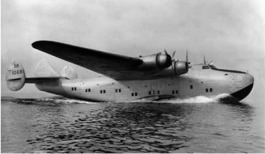
Boeing 314a Clipper
The Clipper was equipped to carry 20 or more people in great luxury. There was a forward cabin, with fixed seats to hold all the passengers on take-off and landing. In flight, fitted with tables, it became the dining room. Aft of that there were lounges, with armchairs, coffee tables, magazines, etc, where we spent most of our day. Further aft were 20 bunks, like the bunks on American trains, where we could undress and go to bed. The crew quarters were on the lower deck.
I don’t remember which of the three Clippers (Bangor, Berwick or Bristol) was used on this crossing. I was probably too excited at the thought of my first transatlantic flight to notice. I had no idea at the time that it would be the first of more than a hundred transatlantic round trips I would make in all kinds of commercial aircraft in coming years.
Crossing the Atlantic by Clipper was a fairly long job. On take-off, I asked the Captain how much fuel they carried. He said they had enough for 17½ hours flying. The winds were said to be favourable enough to attempt the direct crossing from Foynes to Botwood, Newfoundland, even though that would leave us with only about an hour’s fuel in hand. We kept in touch with the crew during the flight. It was obvious they were increasingly doubtful what to do. The winds had been higher than predicted and they approached the point of no return with less fuel than they had hoped for. However they pressed on. We were biting our nails when 17 hours had passed without a landfall. In the event, we landed at Botwood after a flight of 17 hours 20 minutes. We refuelled and were off again in 45 minutes for the 11 hour flight to Baltimore.
I cannot resist the temptation to quote at some length from Winston Churchill’s parallel experiences of his first transatlantic flight in the Boeing Clipper from Norfolk Virginia via Bermuda to Plymouth following his historic meetings with President Roosevelt in 1942:
On the 14th I took leave of the President. He seemed concerned about the dangers of the voyage. Our presence in Washington had been for many days public to the world, and the charts showed more than twenty U-boats on our homeward courses. We flew in beautiful weather from Norfolk to Bermuda, where the Duke of York with escorting destroyers awaited us inside the coral reefs. I travelled in an enormous Boeing flying-boat, which made a most favourable impression upon me. During the three hours’ trip I made friends with the chief pilot, Captain Kelly Rogers, who seemed a man of high quality and experience. I took the controls for a bit, to feel this ponderous machine of thirty or more tons in the air. I got more and more attached to the flying-boat. Presently I asked the Captain, “What about flying from Bermuda to England? Can she carry enough petrol?” Under his stolid exterior he became visibly excited. “Of course we can do it. The present weather forecast would give a forty miles an hour wind behind us. We could do it in twenty hours.” I asked how far it was, and he said, “About thirty-five hundred miles.” At this I became thoughtful.
However, when we landed I opened the matter to Portal and Pound.........The Chief of the Air Staff said at once that he thought the risk wholly unjustifiable, and he could not take the responsibility for it. The First Sea Lord supported his colleague. After a considerable pause Portal said that the matter might be looked into; and that he would discuss it at length with the Captain of the flying-boat and go into weather prospects with the meteorological authorities. I left it at that. Two hours later they both returned, and Portal said that he thought it might be done. The aircraft could certainly accomplish the task under reasonable conditions; the weather outlook was exceptionally favourable on account of the strong following wind. No doubt it was very important to get home quickly..... Of course there was a risk, but on the other hand there were the U-boats to consider. So we settled to go unless the weather deteriorated. The starting time was 2 P.M. the next day......
I woke up unconscionably early with the conviction that I should certainly not go to sleep again. I must confess that I felt rather frightened. I thought of the ocean spaces, and that we should never be within a thousand miles of land until we approached the British Isles. I thought perhaps I had done a rash thing that there were too many eggs in one basket. I had always regarded an Atlantic flight with awe. But the die was cast. Still, I must admit that if at breakfast, or even before luncheon, they had come to me to report that the weather had changed and we must go by sea, I should have easily reconciled myself to a voyage in the splendid ship which had come all this way to fetch us.
Divine sunlight slapped the island, and the favourable weather prospects were confirmed. At noon we reached the flying-boat by launch. We were delayed for an hour on the quay because a picket-boat which had gone to the Duke of York for items of baggage had taken longer than expected.
It was, as the Captain had predicted, quite a job to get off the water. Indeed, I thought that we should hardly clear the low hills which closed the harbour. There was really no danger; we were in sure hands. The flying-boat lifted ponderously a quarter of a mile from the reef, and we had several hundred feet of height to spare. There is no doubt about the comfort of these great flying-boats. I had a good broad bed in the bridal suite at the stern with large windows on either side. It was quite a long walk, thirty or forty feet, downhill through the various compartments to the saloon and dining-room, where nothing was lacking in food or drink. The motion was smooth, the vibration not unpleasant, and we passed an agreeable afternoon and had a merry dinner. These boats have two storeys, and one walks up a regular staircase to the control room. Darkness had fallen, and all the reports were good. We were now flying through dense mist at about seven thousand feet. One could see the leading edge of the wings, with their great flaming exhausts pouring back over the wing surfaces.
I went to bed and slept soundly for several hours. I woke just before the dawn, and went forward to the controls. The daylight grew. Beneath us was an almost unbroken floor of clouds. After sitting for an hour or so in the co-pilot’s seat, I sensed a feeling of anxiety around me. We were supposed to be approaching England from the southwest and we ought already to have passed the Scilly Islands, but they had not been seen through any of the gaps in the cloud floor. As we had flown for more than ten hours through mist and had had only one sight of a star in that time, we might well be slightly off our course after such a lengthy flight. Wireless communication was of course limited by the normal wartime rules. It was evident from the discussions which were going on that we did not know where we were. Presently Portal, who had been studying the position, had a word with the Captain, and then said to me, “We are going to turn north at once.” This was done, and after another half-hour in and out of the clouds we sighted England, and soon arrived over Plymouth, where, avoiding the balloons, which were all shining, we landed comfortably.
As I left the aircraft the Captain remarked, “I never felt so much relieved in my life as when I landed you safely in the harbour.” I did not appreciate the significance of his remark at the moment. Later on I learnt that if we had held on our course for another five or six minutes before turning northward we should have been over the German batteries in Brest. We had slanted too much to the southward during the night. Moreover, the decisive correction which had been made brought us in, not from the southwest, but from just east of south – that is to say, from the enemy’s direction rather than from that from which we were expected. This had the result, as I was told some weeks later, that we were reported as a hostile bomber coming in from Brest, and six Hurricanes from Fighter Command were ordered out to shoot us down. However, they failed in their mission.
To President Roosevelt I cabled, “We got here with a good hop from Bermuda and a thirty-mile wind.”
The Second World War, The Grand Alliance by Winston S. Churchill; Houghton Mifflin, 1959. pp706-711
I was in Washington for about six weeks. I had an office in the Combined Chiefs of Staff building and attended more than one of their plenary meetings. Washington was intolerably hot and humid, but it was freezingly cold in the back row of those meetings. I was glad to get on with the more detailed planning meetings with the representatives of the three US Services. I was about half the average age at these meetings, which were ludicrously formal, ponderous and slow on our wartime standards. I suppose you could forgive them for they had not had their backs to the wall as we had. I found it very hard to convince them that I had the plenary powers of the UK Government and could make any decision on the spot, without “referring back to my Department”, which seemed to be necessary for all the Americans, even though they held the rank of General or Admiral. I was also the only one there who knew the Mark III system inside out (after all, I had designed much of it) so I found I could easily get my way by ‘blinding them with science’.
When I checked in Baltimore for the return flight our baggage was meticulously checked and weighed and we were then informed that there was a couple of hours delay. It was going on for midnight but I decided to take a stroll to see a little of Baltimore, albeit at night. It is a salutary thought that personal security in the city at night was not a significant consideration in those days. I remember dropping in to an all-night drug store and teaching a rather attractive young lady behind the counter how to make a good cup of tea. The flight back was also by Clipper via Botwood and Foynes. This time, however, the Clipper completed the last leg of the flight to Poole Harbour on the South coast of England. Thankfully, the flight was uneventful.
When I got back to Malvern, although we had no idea what the future held, Nesta and I decided to get married.

Snapped leaving the church
We were married in the parish church at West Malvern on the 1st November, 1944. We decided to revisit Swanage for our honeymoon, but stopped off at the famous Mitre Hotel in Oxford en route. Once in Swanage, my former landlady, Mrs. Suttle, with her usual extreme kindness, offered us my old rooms (which were really theirs) for the honeymoon. We had been there three days when I received a telegram saying curtly that I had been posted to Washington D.C. for an indefinite period and was to report immediately to Watson-Watt’s office in London.
Of course, knowing that wives were not normally allowed to travel on these oversea postings, we tore up to London and burst into Watson-Watt’s office, looking very anxious. As we entered, Robert raised his hand, as if in blessing and said “It’s OK, I got special dispensation from the Minister this morning.” We had no idea at the time that this was all part of an immensely generous plot that had been cooked up by Bowden, Denis Taylor and other TRE colleagues, in which Watson-Watt had wholeheartedly joined. I do not believe we ever thanked our benefactors adequately but have always been immensely grateful for their kind concern. So, our honeymoon was to be continued en route to the U.S.A. We were to sail to New York on the Mauritania, which was, in essence a troopship. When we arrived in Liverpool a few days later, the Embarkation Officer refused to take Nesta’s fare, saying “It says here it is Government paid.” That was in spite of an official letter I held to the contrary.
One of the casualties of this upheaval was the Marendaz Special which had to be sold in a hurry (for 25 pounds) because we had nowhere to keep it during our absence. I was very sad to lose it. I sometimes wonder if it is one of those that survived so remarkably to the present day.
When we eventually boarded the Mauritania, we found that the ship was very crowded with troops and the wives and children of other troops. All the accommodation appeared to consist of crowded dormitories. But we were given a private cabin. We were puzzled, feeling there must have been a mistake, but a mistake we had no difficulty living with! So we relaxed and enjoyed the crossing, in spite of the zig-zagging of the independently-routed ship and the re-routing in mid-Atlantic to Halifax to avoid a submarine pack in the New York area. The pitching of the Mauritania steaming flat out in the rough seas was spectacular, like a repeated four-floor elevator ride, with the terrible vibration of the screws as they lost purchase when the ship was nose down.
Apart from the 40 minutes I had spent in Botwood Newfoundland a couple of months earlier, the train ride from Halifax to Montreal was my first taste of Canada and, of course it was Nesta’s very first sight of it. Most of the passengers on the Halifax-Montreal train were returning troops and, at every stop, local people would come aboard with fruit and other goodies. It gave us a good feeling for Canada which no doubt contributed subconsciously to our decision, in 1951, to settle there.
